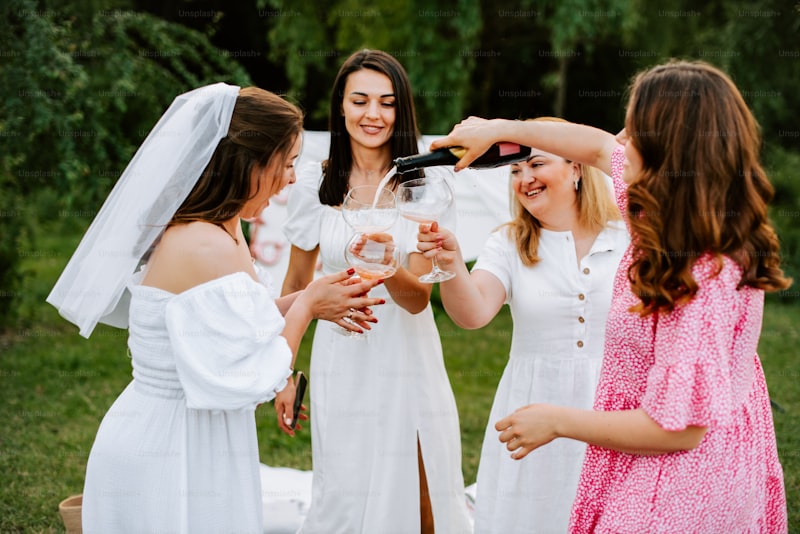Bridal Party Roles Through the Ages: A Comprehensive Guide
Understanding the Evolution of Bridal Party Roles
The concept of a bridal party is a time-honored tradition that has evolved significantly over the centuries. From the earliest days of wedding ceremonies to modern celebrations, the roles within the bridal party have transformed. This article explores the various roles and responsibilities held by members of the bridal party throughout history, offering insights and suggestions for today’s brides and grooms.
The Historical Context of Bridal Party Roles
In ancient civilizations, weddings were far more than just personal commitments; they were social and economic contracts between families. The bridal party initially consisted of close family members and friends who were there to support the couple in both ceremonial and logistical activities.
Ancient Times to the Middle Ages
During ancient times, brides had companions, often called "bridesmaids," who were typically chosen from their closest friends or family. Their roles primarily centered on providing emotional support and assisting the bride with her marriage preparations. In some cultures, bridesmaids wore similar clothing to the bride to confuse evil spirits who might seek to harm her.
| Time Period | Bridal Party Roles | Key Responsibilities |
| Ancient Times | Bridesmaids and Groomsmen | Emotional Support and Protection |
| Medieval Europe | Bridesmaids, Groomsmen, and Page Boys | Assisting with Wedding Arrangements |
| Modern Era | Best Man, Maid of Honor, Flower Girl | Roles in Ceremonies and Receptions |
Bridal Party Roles in Modern Weddings
As we moved into the Modern Era, the bridal party saw changes in nomenclature and responsibilities. Today’s weddings typically feature a more defined set of roles.
The Bride's Party
The bride's party often consists of a Maid/Matron of Honor, bridesmaids, and flower girls. The Maid of Honor is the bride's primary support, helping with planning, organization, and emotional guidance. Bridesmaids support her in various ways, including helping with address lists, dress fittings, and coordinating pre-wedding events. Flower girls often symbolize innocence and purity, adding a charming element to the ceremony.
The Groom's Party
On the groom's side, the Best Man and groomsmen play essential roles. The Best Man is responsible for organizing the bachelor party, ensuring the groom’s needs are met, and delivering a toast at the reception. Groomsmen assist in countless ways, including managing the guest list and bringing an upbeat energy to the wedding day.
Roles That Have Become Popularized
In recent years, weddings have seen an influx of additional roles that reflect evolving societal norms. Consider the following key roles:
Flower Child and Ring Bearer
While traditionally small children, the flower child and ring bearer embody purity and innocence, adding a whimsical touch to the wedding processional. Their roles usually include scattering flower petals and carrying the rings on a decorative pillow.
Bridal Party Alternates
More inclusive wedding parties have introduced roles like “Best Woman” or “Man of Honor,” ensuring that friends of any gender can support the couple on their special day.
Responsibilities of the Bridal Party
The bridal party is charged with duties that can vary significantly. Key responsibilities include:
- Planning Events: Organizing pre-wedding events such as bachelor/bachelorette parties and bridal showers.
- Support: Providing emotional backing to the couple throughout the planning process and on the wedding day.
- Coordination: Ensuring the ceremony runs smoothly, including helping to organize guests during the processional and reception.
- Participation: Actively taking part in wedding rehearsals and ensuring all members know their roles during the ceremony.

The Significance of Bridal Party Dynamics
The dynamics within the bridal party can significantly influence the overall wedding experience. A well-functioning bridal party creates a support system that alleviates stress for the couple and contributes to a joyful celebration.
Modern Challenges & Tips
While the evolution of bridal party roles has made weddings more inclusive and fun, it has also introduced some challenges:
Communication and Clarity
With diverse roles and responsibilities, clear communication is critical. Couples should set expectations early on and communicate any particular wishes or requirements for their bridal party.
Managing Conflicts
Differences in personality or opinions can occasionally arise within the bridal party. It’s vital for the couple to remain neutral and prioritize the occasion's joy over personal grievances.
Budget Considerations
Discussing expectations regarding costs incurred by the bridal party is essential. Expenses can include attire, travel, and pre-wedding events, and transparency helps in preventing misunderstandings.
Conclusion: Embracing Bridal Party Traditions in Today’s Culture
From ancient times to modern celebrations, the roles of the bridal party have adapted to the social and cultural changes of each era. Today, these roles are more varied and representative of the individuals in the wedding party, allowing for greater personal expression and diversity.
As you plan your wedding, remember the significance of each member of your bridal party. Their support not only makes the day go smoothly but also helps create lasting memories. By appreciating the evolution of these roles and their importance, you can create a truly unique and fulfilling wedding experience for yourselves and your loved ones.
In summary, understanding and embracing the various roles of the bridal party can enhance the wedding planning process and the wedding day itself. Communicate openly with your bridal party to ensure everyone knows their responsibilities, and don’t hesitate to start new traditions that feel right for you.